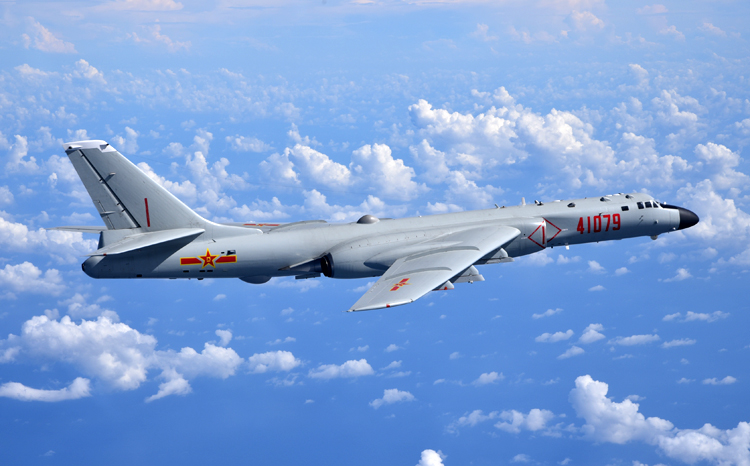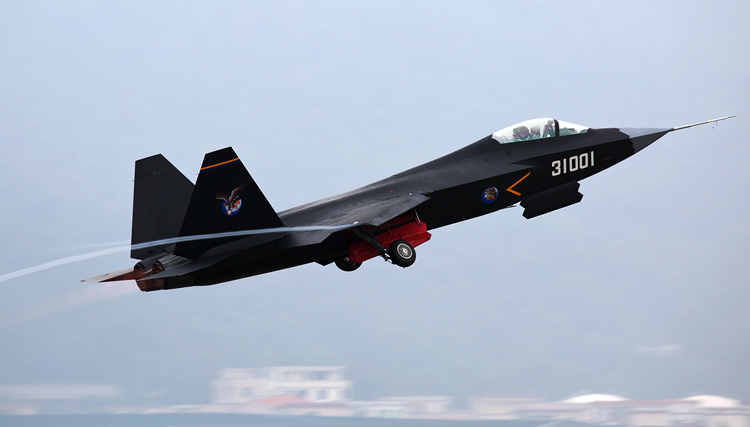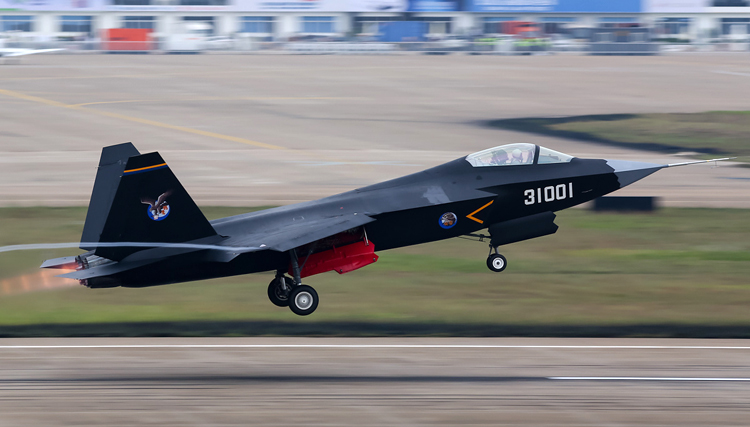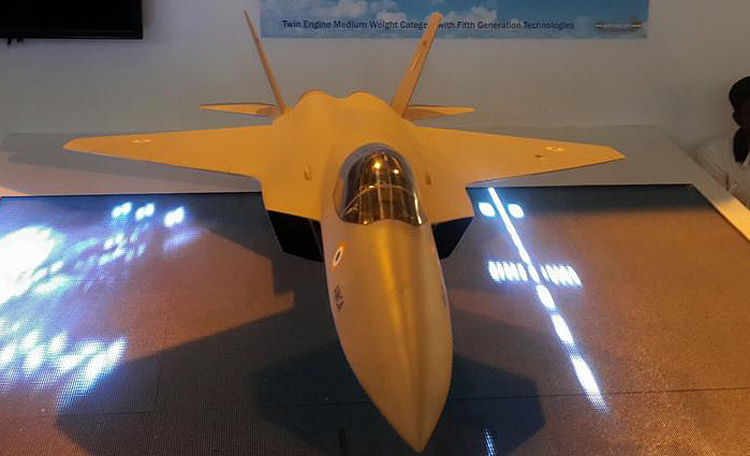INDIAN ARMED FORCES CHIEFS ON
OUR RELENTLESS AND FOCUSED PUBLISHING EFFORTS

SP Guide Publications puts forth a well compiled articulation of issues, pursuits and accomplishments of the Indian Army, over the years

I am confident that SP Guide Publications would continue to inform, inspire and influence.

My compliments to SP Guide Publications for informative and credible reportage on contemporary aerospace issues over the past six decades.
China's Stealth Bomber and Stealth Fighter
China has been developing an advanced strategic bomber Xian H-20 with a range up to 8,000 km. It is developed according to the aerodynamic design “flying wing” with the use of stealth technologies. The PLAAF expects to start operating it in 2025, replacing the obsolete N-6 bombers.
 |
The Author is Former Director General of Information Systems and A Special Forces Veteran, Indian Army |

China’s present stealth bomber ‘Xian H-6’ is a license-built version of the Soviet Tupolev Tu-16 twin-engine jet bombers, built for China's People's Liberation Army Air Force (PLAAF). Delivery of the Tu-16 to China began in 1958, and a license production agreement with the Soviets was signed in the late 1950s. Xi’an Aircraft Industrial Corporation (XAC) manufactured aircraft at Xi'an as the ‘H-6’ with the first flying in 1959. By November 2020, the PLAAF had 231 x H-6 of various configurations. The latest variant of the H-6 is the H-6N, capable of aerial refueling and armed with air-launched cruise missiles, which according to the US Department of Defence (DoD) gives the PLAAF long-range standoff offensive air capability with precision-guided munitions (PGMs).
Since the beginning of the 2000s, China has been developing an advanced strategic bomber Xian H-20 with a range up to 8,000 km. The prototype of this aircraft first took to the skies in 2013. It is developed according to the aerodynamic design "flying wing" with the use of stealth technologies. The PLAAF expects to start operating it in 2025, replacing the obsolete N-6 bombers (copy of the Soviet Tu-16).
The latest variant of the H-6 is the H-6N, capable of aerial refueling and armed with air-launched cruise missiles, gives the PLAAF long-range standoff offensive air capability with precision-guided munitions (PGMs)
Photographs of China’s new under development stealth bomber ‘Yuan Hong’ have recently emerged on the web. Yuan Hong will likely become a key project for China’s military-industrial complex for the period of the 14th five-year plan (2021-2025). Judging by the image, Yuan Hong will be built according to the "flying wing" aerodynamic scheme to increase the radar stealth of the structure. It is assumed to be a bomber of heavy type and in its arsenal will likely include newly developed long-range hypersonic air-to-surface missiles, including those with nuclear warheads. Outwardly, the Yuan Hong is very similar to the X-47B, an American multipurpose attack UAV from Northrop Grumman.
China is actively pushing for exporting its indigenously developed FC-31 stealth fighter jet on the international market while facing competition from rivals like the American F-35 and the Russian Su-75. A dedicated office has been established, putting together resources from the manufacturing company Shenyang Aircraft Company (SAC) under the state-owned Aviation Industry Corporation of China, the research institute and the China National Aero-Technology Import and Export Corporation to promote exports of the FC-31 under a development tactic of "self-oriented active promoting" aimed to cultivate targeted users.

According to SAC, the FC-31 (also known as J-31) is a single seat, twin-engine, medium-sized multi-role fighter jet with outstanding stealth capabilities, strong situational awareness, high maneuverability, advanced integrated logistics and good cost-effectiveness. China could even have deeper cooperation with foreign customers by building assembly lines in the customer's country.
China has made good use of air shows to showcase the FC-31's technical advantages. The FC-31, China's second stealth fighter jet after the J-20, was recently put on display at the Air Show China in Zhuhai, South China's Guangdong Province, from late September to early October 2021, together with the powerful PL-15E beyond-visual-range air-to-air missile. Reports suggest that the FC-31 will also become China's next-generation aircraft carrier-based fighter jet.
Media reports have quoted Wei Dongxu, a Beijing-based military expert, saying that the international market of stealth fighter jets is far from saturated. Wei said, “The US F-35 stealth fighter jet mainly targets US allies and partners, and while many countries want to procure it, they lack enough budget or face a wide range of export restrictions set by the US. Russia has revealed its new Su-75 stealth fighter, but it has yet to make its maiden flight. China's FC-31 is technically mature, can be fully domestically produced and enjoys advantages including high technology, acceptable pricing, the lack of political restrictions and complete service, as China can also provide a full set of airborne equipment and weapons.”
China is actively pushing for exporting its indigenously developed FC-31 stealth fighter jet on the international market while facing competition from rivals like the American F-35 and the Russian Su-75
In April 2009, the Wall Street Journal had reported that Chinese computer spies had penetrated the database of the America’s Joint Strike Fighter programme acquiring terabytes of secret information, and the stolen knowledge has been incorporated in China’s FC-31 fighter programme. This is hardly surprising considering that China has been acquiring foreign technologies using all possible means and is expert in reverse engineering.
The FC-31 can carry 8,000 kg of payload, with four munitions totaling 2,000 kg internally, and 6,000 kg carried on six external hard-points; primary armaments include the PL-10 short-range missile and PL-12 medium-range air-to-air missile. 4 x PL-21 missiles can also be fitted inside the FC-31's internal weapons bay. It has a combat radius of 1,200 km and a maximum take-off weight of 25,000 kg. The FC-31 is speculated to use stealth coatings instead of "baked in" fiber-mat stealth. It would be stealthy against L-band and Ku-band radars, and would be low-observable against a number of multi-spectrum sensors. The engine nozzles are apparently redesigned to reduce radar and infrared signatures.

According to US military and industry officials, the capability of the FC-31 against the newest fighters, like the American F-22 and F-35, would depend on factors such as numbers of platforms, quality of pilots, and capabilities of radars and other sensors. On July 7, 2017, The Pakistan Air Force had announced its Project ‘Azm’ to develop fifth-generation fighter (PAC PF-X) and Stealth MALE UAVs. These obviously will be in collaboration with China though Pakistan is also seeking joint development of UAVs and UCAVs in collaboration with Turkey.
India’s Advanced Medium Combat Aircraft (AMCA) programme to develop fifth generation fighter aircraft for the Indian Air Force (IAF) and the Indian Navy (IN) will also include sixth generation niche technologies
India’s Advanced Medium Combat Aircraft (AMCA) programme to develop fifth generation fighter aircraft for the Indian Air Force (IAF) and the Indian Navy (IN) will also include sixth generation niche technologies. It is expected to be produced by a public-private joint venture between the Hindustan Aeronautics Limited (HAL) and an Indian private company. Approval of the Defence Acquisition Committee (DAC) headed by the Defence Minister, for the AMCA project is likely to be accorded in 2022. The development cost is estimated to be around 15,000 crore.

The AMCA will be a single-seat, twin-engine, stealth all-weather swing-role fighter aircraft. AMCA Mark 1 will come equipped with fifth generation technologies and Mark 2 will have the incremental sixth generation technology upgrades. The AMCA is intended to perform a multitude of missions including air superiority, ground strike, suppression of enemy air defences (SEAD) and electronic warfare (EW). The AMCA design is optimised for low radar cross section and super-cruise capability. The first flight is expected to be by 2025-26 and serial production may begin by 2028-2030.





